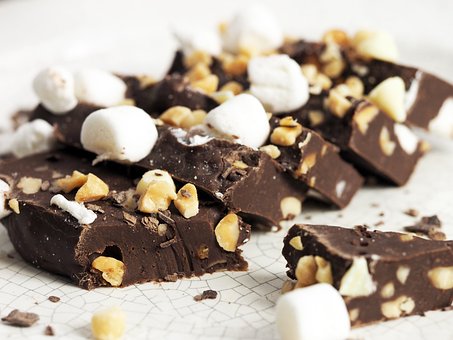 My father loves fudge. If we go anywhere that sells fudge, he has to stop and buy some. Over the years, he acquired multiple recipes including one that could be made in the microwave. I've never liked fudge that much because it contains too much sugar.
My father loves fudge. If we go anywhere that sells fudge, he has to stop and buy some. Over the years, he acquired multiple recipes including one that could be made in the microwave. I've never liked fudge that much because it contains too much sugar.As far as anyone can tell, fudge is an American invention, just like Brownies. The story goes that a batch of caramels didn't go well and was described as "fudged"or bungled, thus it got its name.
Fudge is defined as a candy with a crystalline structure. If the sugar solution is properly heated, the crystallization will lead to a great fudge. In fact, it is the temperature that makes the difference between hard caramels and fudge.
It appears that fudge was first sold in Baltimore in 1886 at 40 cents per pound. It was made by the cousin of a student at Vassar College. Someone found a letter at Vassar College in which Emelyn Battersby Hartridge requested the recipe from that student's cousin. The recipe was sent and Emelyn made 30 pounds for the Senior Auction. It proved to be so popular that many students tried making it in their rooms by cooking it over gas lamps.
In 1894, a student sent her father a batch of fudge as a birthday present. She included a note explaining what went into making her gift. References to this activity began appearing in newspapers and in 1895, an article appeared in the Brownsville, Texas newspaper.
This is at a time when it is believed that females needed to eat bland food so as not to upset their delicate constitutions. In fact, many considered fudge to be a vice along the same lines as smoking or drinking. At the same time as articles were appearing in the newspapers, many schools worked to develop their own fudge recipes.
By 1903, recipes for Vassar Fudge and Smith College Fudge started appearing in cookbooks. The basic recipe for the early fudges are simple. Its a mix of sugar, butter, and milk or cream cooked to the soft ball stage and then beaten till the mixture has obtained a smooth creamy stage. In these early days, many people did not own candy thermometers so they had to rely on dropping a bit of fudge in a glass of water. The mixture often ended up undercooked or over cooked.
This lead to people developing fool proof recipes that added corn syrup to prevent crystallization or by adding marshmallow creme, sweetened condensed milk, or other ingredients guaranteed to prevent crystallization but these additives did not guarantee the same creamy texture.
Over time, everyone has adopted their favorite recipe. As I said, my father always made microwave fudge which wasn't always smooth. In fact it was more crystallized but he loved it anyway. Let me know what you think, I'd love to hear. Have a great day.
No comments:
Post a Comment